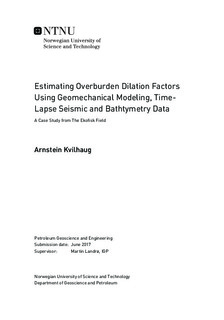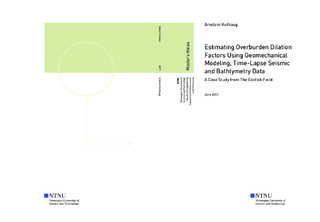| dc.description.abstract | As reservoir compaction is causing variations in both layer thickness and seismic velocities, it is of interest to distinguish between these two effects. The dilation factor R can be used to link the geophysical observables and the physical properties of the rock. The R-factor is defined as the ratio of relative change in velocity to relative change in strain. There are still unanswered questions related to the variation of the R-factor.
We suggest inverting for a set of reservoir parameters to obtain the relative thickness change above the reservoir, using geomechanical modeling constrained by seafloor subsidence, measured from repeated bathymetry measurements. The resulting R-factor values will be calculated through a rock physics relation using the modeled relative thickness change and the corresponding relative time shifts provided by 4D seismic. The global inversion process has been implemented using real data from the Ekofisk Field, located in the Southern North Sea, acquired in 2011 and 2014.
The resulting R values will depend on the accuracy of the model parameters in which the inversion process define. It is hard to determine the underlying real model parameter since the geomechanical model will not reflect the complexity of the Ekofisk reservoir. The calculated R values will, therefore, be associated with errors. Negative overburden time shifts were recorded, representing speedup in the monitor case. Even though the study was implemented on a 2D seismic line with increasing positive time shifts with depth, it seems like the constrained displacements together with the relative time shifts do not reflect the stress paths estimated from the geomechanical model. The method still provides knowledge of the processes involved. The calculated R will depend on the stress path from the geomechanical model and the interaction with time shifts from seismic data and may differ both laterally and with depth, depending on the interaction. The study illustrates the importance of collecting data where time-lapse changes are most prominent and how the calculated R-factor becomes unstable for position larger than the underlying reservoir radius. The instabilities are dependent on depth, and the effect occurs at a larger position for shallow- compared to deeper layers due to stress arching. The scientific approach used in this study can potentially be utilized with more accurate geomechanical models, which account for heterogeneities and non-elastic effects in the reservoir and overburden, in order to calculate the R-factor values more precise. | |

